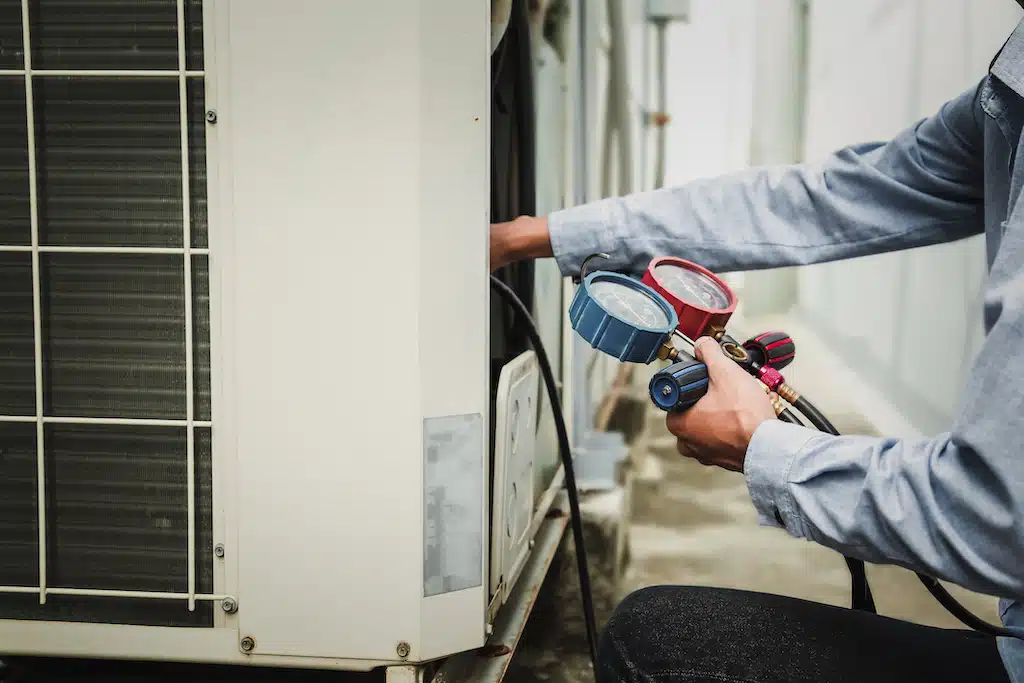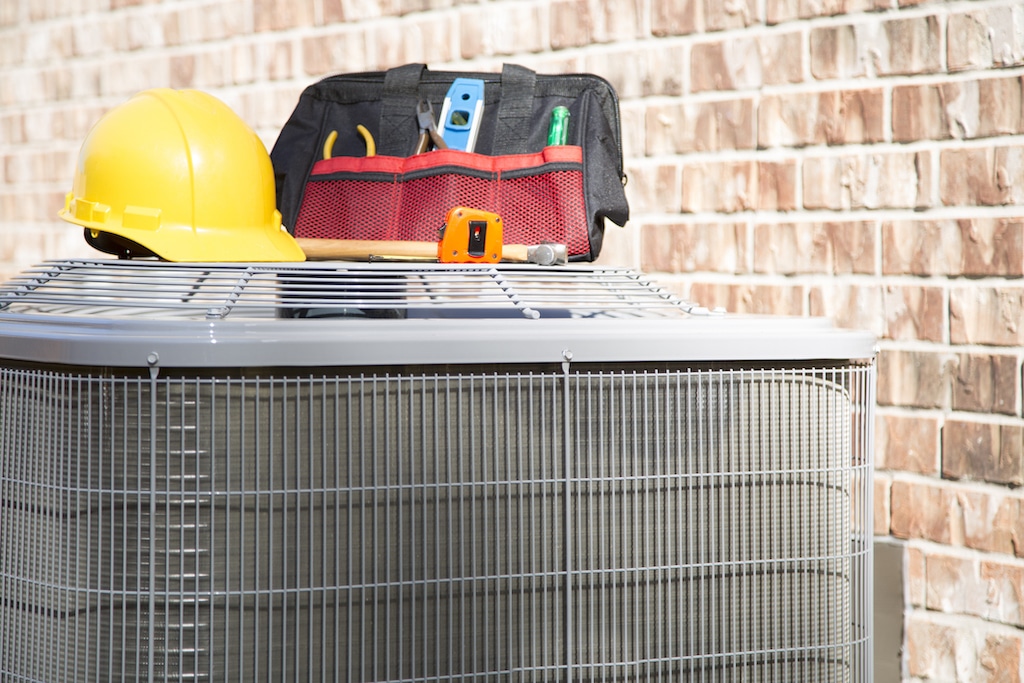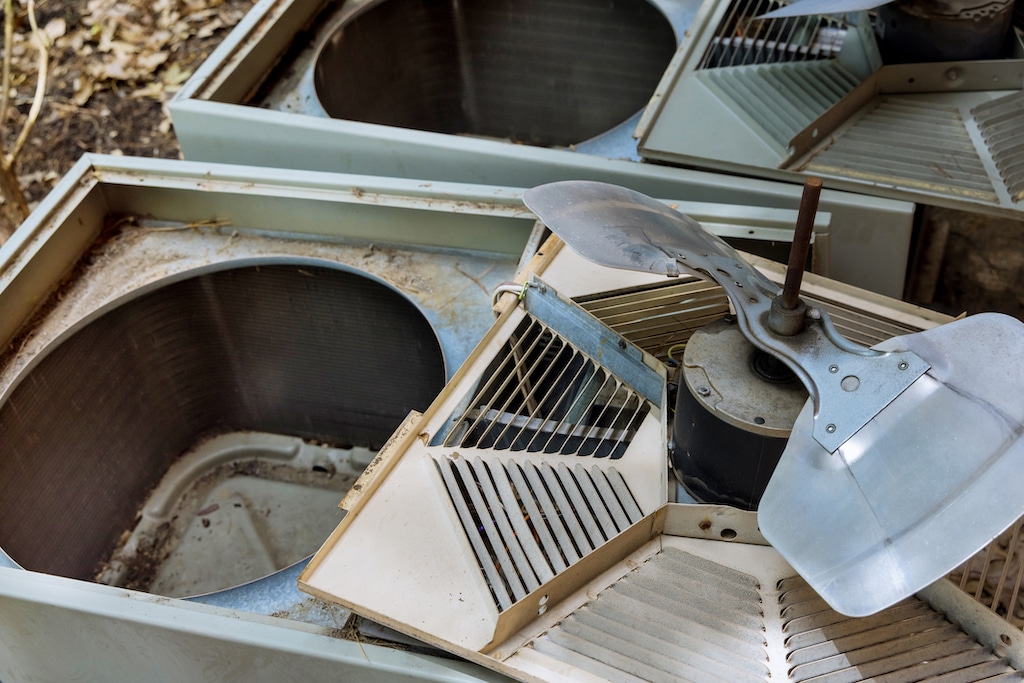
Mastering the World of Heating and AC Repair: A Comprehensive Guide
Have you ever found yourself in the midst of a sweltering summer day or a freezing winter night, pondering, “What’s involved in Heating and AC repair?”
If so, you’re certainly not alone. For countless homeowners, particularly those hovering around the median age of 55, the complexities of heating and AC systems are more than just a topic of casual conversation.
They represent the fine line between comfort and discomfort in their homes.
These systems, often taken for granted, play a pivotal role in our daily lives, ensuring our living spaces remain habitable regardless of the whims of Mother Nature.
Yet, when they falter, many are left in the lurch, unsure of the next steps. This is precisely why understanding the intricacies of heating and AC systems isn’t just a luxury—it’s an absolute necessity.
In this article, we’ll embark on an enlightening journey through the vast realm of Heating and AC repair.
Our mission?
To arm you with a thorough understanding, actionable tips, and expert advice, ensuring that the next time your system acts up, you’re not left scratching your head in confusion but are instead equipped with the knowledge to make informed decisions.
The Essence of Heating and AC Repair
Every home, whether it’s a cozy apartment or a sprawling mansion, relies heavily on its heating and AC system to maintain a comfortable environment.
As seasons change, bringing with them the sweltering heat of summer or the biting cold of winter, it’s these systems that stand as our first line of defense, ensuring our living spaces remain habitable and pleasant.
But what exactly goes into keeping these systems running smoothly?
That’s where the realm of Heating and AC repair comes into play.
Heating and AC repair isn’t just about fixing a broken component; it’s an intricate blend of art and science.
Professionals in this field possess a deep understanding of the mechanics and electronics that power these systems. They’re equipped not only with the technical know-how but also with a keen sense of diagnosis, allowing them to pinpoint Heating and AC Repair issues that might escape the untrained eye.
Routine maintenance forms the backbone of Heating and AC repair. Just as we visit doctors for regular check-ups, our heating and AC systems require periodic inspections.
These check-ups ensure that every component, from the filters to the thermostats, is in optimal condition. They help in identifying potential Heating and AC Repair issues before they escalate, ensuring the system’s longevity and efficiency.
However, despite the best maintenance practices, systems can and do malfunction. Sometimes it’s a minor glitch, easily fixable with a simple tweak.
At other times, the issues are more significant, demanding a comprehensive approach to resolution.
Whether it’s a refrigerant leak, a malfunctioning compressor, or a thermostat that’s lost its calibration, Heating and AC repair professionals are trained to address these problems, ensuring our homes remain comfortable sanctuaries regardless of the weather outside.
Why Regular Maintenance Matters
Imagine waking up on a chilly winter morning, only to find that your home’s heating system has given up the ghost.
Or picture a scorching summer afternoon when your AC decides to take an untimely break.
Such scenarios underscore the importance of regular maintenance for your heating and AC system.
Drawing a parallel, your HVAC system is very much akin to a vehicle. And just as we wouldn’t dream of driving our cars for years without regular oil changes, tire rotations, and inspections, our heating and AC systems demand a similar level of attention.
Cars, when neglected, can break down, leaving you stranded on a lonely road. Similarly, a heating and AC system that’s overlooked can malfunction, leaving you and your family grappling with discomfort.
This is where the essence of Heating and AC repair and maintenance comes into sharp focus. Periodic check-ups ensure that every component of the system, from the ducts to the filters and thermostats, functions optimally.
These routine inspections can catch potential Heating and AC Repair issues, like a worn-out part or a clogged filter, before they escalate into more significant, often more expensive, problems.
Efficiency is another crucial aspect of regular maintenance. An efficient system doesn’t have to work as hard to maintain the desired temperature, leading to reduced energy consumption and, by extension, lower utility bills.
Over time, this can translate to substantial savings, making those periodic maintenance checks a wise investment.
Furthermore, regular maintenance can significantly extend the lifespan of your heating and AC system.
Just as timely oil changes and inspections can add years to your car’s life, routine HVAC check-ups can ensure your system serves you reliably for years, if not decades.

Photo By fstop123 at iStock
Common Heating and AC repair Issues and Their Solutions
Navigating the intricate world of Heating and AC repair can sometimes feel like deciphering a complex puzzle.
With numerous components working together to ensure our homes stay comfortable, it’s no surprise that Heating and AC Repair issues can arise.
From the seemingly benign thermostat glitches to the more concerning refrigerant leaks, homeowners often find themselves grappling with a range of challenges.
Let’s delve deeper into some of these common problems and explore their potential solutions.
Thermostat Glitches
The thermostat acts as the brain of your HVAC system, controlling and regulating the temperature to ensure a comfortable environment.
However, like any electronic device, it can face Heating and AC Repair issues. Sometimes, the thermostat might lose its calibration, leading to temperature discrepancies.
In other instances, it might face electrical problems, causing it to malfunction or not work at all.
While minor Heating and AC Repair issues like battery replacements can be addressed by homeowners, recurrent glitches or complex problems might necessitate a professional’s touch. Upgrading to a modern, programmable thermostat can also offer enhanced efficiency and control.
Refrigerant Leaks
Refrigerants play a pivotal role in your AC system, cooling and condensing the air.
However, leaks can occur, leading to reduced cooling efficiency and potential environmental concerns. Identifying a refrigerant leak isn’t always straightforward. Homeowners might notice ice formation on the coils or a hissing sound, indicating a leak.
Addressing this issue is crucial, not just for the system’s efficiency but also for environmental compliance.
While some might attempt a DIY fix by detecting the leak and refilling the refrigerant, it’s essential to ensure the correct type and amount.
Given the complexities and potential environmental impact, seeking professional help for refrigerant issues is often the best course of action.
Filter Clogs
Air filters are the unsung heroes of the HVAC world, trapping dust, pollen, and other contaminants, ensuring clean air circulation in our homes.
Over time, these filters can become clogged, leading to reduced airflow, increased strain on the system, and decreased air quality. Regularly checking and replacing or cleaning these filters is paramount.
A clogged filter can force the system to work harder, leading to increased energy consumption and wear and tear.
Homeowners should make it a routine to inspect filters, especially during peak usage seasons. For those living in areas with higher pollution or allergens, considering HEPA filters or other advanced options might be beneficial.
Drainage Problems
The HVAC system produces condensation, which typically drains away without any Heating and AC Repair issues.
However, blockages can occur, leading to water pooling, potential system damage, and even mold growth. Regular cleaning and maintenance can prevent such blockages.
If homeowners notice water accumulation or signs of mold, it’s essential to address the issue promptly.
While cleaning the drain and ensuring proper drainage can be a DIY task, persistent problems might indicate a more significant underlying Heating and AC Repair issue, warranting professional intervention.
In the vast domain of Heating and AC repair, understanding these common issues and their solutions can empower homeowners to take proactive measures, ensuring their systems run efficiently and reliably.
However, when in doubt, seeking professional expertise is always a wise decision.
Recognizing the Signs of Trouble
Noises and Odors: Silent Alarms
Just as a car might grunt or groan before a breakdown, your HVAC system too has its own set of silent alarms.
Among the most common and telling signs are strange noises and unusual odors emanating from the system.
Have you ever been startled by a sudden grinding, buzzing, or whirring sound from your HVAC unit?
Such noises can be indicative of various Heating and AC Repair issues, from a failing motor struggling to keep up to a loose belt or even debris caught within the system. Ignoring these sounds can lead to more significant problems down the line, potentially culminating in a complete system breakdown.
Equally telling are unusual odors.
A musty scent, for instance, can be a red flag, pointing towards mold growth within the ducts. Mold not only compromises the efficiency of the system but can also pose serious health risks to the home’s occupants.
On the other hand, a burning smell might indicate overheating components, demanding immediate attention.
Temperature Inconsistencies
One of the primary goals of any HVAC system is to provide consistent temperature regulation throughout a home.
However, in the vast domain of Heating and AC repair, one common issue that professionals often encounter is temperature inconsistencies. When you walk from one room to another and feel a stark difference in temperature, it’s a clear indication that something’s amiss.
Imagine settling into your living room, wrapped in warmth, only to step into your bedroom and feel like you’ve entered a freezer.
Or perhaps the kitchen feels like a sauna, while the dining area is chilly. Such disparities in temperature can be both uncomfortable and concerning.
The root of these inconsistencies can often be traced back to Heating and AC Repair issues with the system’s distribution.
Blocked or leaky ducts, for instance, can impede the even distribution of air, leading to hot or cold spots in different areas of the house. Similarly, an improperly calibrated or malfunctioning thermostat might not accurately regulate the temperature, causing disparities.
Skyrocketing Energy Bills
In today’s world, where energy conservation and cost-efficiency are paramount, a sudden and unexplained surge in your energy bills can be alarming.
Within the context of Heating and AC repair, such spikes are often more than just a financial concern; they serve as red flags, signaling potential Heating and AC Repair issues with your HVAC system.
If you’ve noticed that your bills are climbing, yet your usage patterns remain unchanged, it’s likely that your heating and AC system is operating below its optimal efficiency.
Over time, various factors, from clogged filters and leaky ducts to malfunctioning thermostats, can strain the system. This strain forces it to work harder, consuming more energy to achieve the same results.
The DIY Approach vs. Hiring Professionals
When to DIY
In the digital age, where information is just a click away, the DIY spirit is more alive than ever.
When it comes to Heating and AC repair, many homeowners feel empowered to tackle minor issues themselves, saving both time and money.
But how do you discern between a task that’s DIY-friendly and one that requires professional intervention?
Changing filters, for instance, is a routine maintenance task that most homeowners can manage with ease. Filters play a pivotal role in ensuring clean air circulation, and replacing them periodically can boost system efficiency and improve indoor air quality.
Similarly, if your system suddenly stops working, it might be due to a tripped circuit breaker. Resetting it can often restore functionality without the need for professional help.
Armed with a comprehensive manual, and perhaps aided by a tutorial video or two, these tasks become even more approachable.
The internet is replete with resources, guides, and forums dedicated to Heating and AC repair, making it easier for homeowners to understand their systems better and address minor issues.
However, while the DIY approach is commendable and can be cost-effective, it’s crucial to recognize its limits. For more complex problems or tasks that involve safety risks, seeking professional expertise is always the wiser choice.
The Value of Expertise
While the DIY spirit has its merits, there are times when the intricate world of Heating and AC repair demands a level of expertise that only professionals can provide.
Complex Heating and AC Repair issues, nuanced diagnostics, and intricate repairs often go beyond the scope of even the most enthusiastic DIYer.
Consider, for instance, a refrigerant leak or a malfunctioning compressor. Such problems not only require specialized tools for diagnosis and repair but also a deep understanding of the system’s workings. Professionals in the field of Heating and AC repair undergo rigorous training and accumulate years of experience, equipping them with the knowledge to address these challenges efficiently and effectively.
Moreover, safety is paramount.
HVAC systems involve electrical components, potentially harmful refrigerants, and other elements that can pose risks.
A professional ensures that repairs and maintenance adhere to industry standards, minimizing any potential hazards. Their expertise guarantees not only the longevity and efficiency of the system but also the safety and well-being of your home and its occupants.

Photo By PeopleImages on iStock
The Financial Aspect: Costs and Savings
Investment vs. Long-Term Benefits
When homeowners consider the expenses associated with Heating and AC repair, it’s essential to view them not just as immediate outlays but as long-term investments.
The upfront costs of regular maintenance and timely repairs can indeed be a concern, but the long-term benefits they yield often outweigh these initial expenditures. Let’s break down the various facets of this investment and the myriad benefits it brings:
Upfront Costs of Maintenance
Regular check-ups, cleaning, and minor fixes come with their associated costs. Whether it’s replacing worn-out components, cleaning ducts, or calibrating thermostats, there’s an immediate expense involved.
Prevention of Major Breakdowns
By investing in routine maintenance, homeowners can often detect and address potential Heating and AC Repair issues before they escalate.
This proactive approach can prevent major malfunctions that not only disrupt comfort but also come with hefty repair or replacement bills.
Efficient Operation and Energy Savings
A well-maintained HVAC system operates at its peak efficiency.
This means it consumes less energy to provide the desired temperature, leading to reduced energy bills. Over months and years, these savings can be substantial, offsetting the costs of maintenance.
Extended System Lifespan
Just like a car that’s regularly serviced tends to run longer, an HVAC system that receives timely care and attention is likely to have an extended operational life.
This means homeowners can defer the significant expense of system replacement, getting the most out of their initial investment.
Enhanced Home Value
A well-maintained heating and AC system can be a selling point if homeowners decide to put their property on the market.
Potential buyers often view a robust HVAC system as a sign of a well-cared-for home, potentially boosting its market value.
Comfort and Peace of Mind
Beyond the tangible financial benefits, there’s an intangible yet invaluable advantage to regular maintenance: peace of mind. Knowing that your system is in top shape and unlikely to break down unexpectedly offers homeowners a sense of security and comfort.
Financing and Discounts
Navigating the financial aspects of Heating and AC repair can sometimes be daunting, especially when faced with significant repair costs or the need for system replacements.
However, homeowners should be aware that many service providers have taken steps to ease this financial burden, offering a range of financing options and discounts.
Financing Options
Recognizing the essential nature of heating and AC systems, especially in extreme weather conditions, many professional service providers offer financing plans.
These plans can spread the cost of significant repairs or system replacements over several months or even years. This allows homeowners to address urgent HVAC needs without being immediately burdened by the full expense.
Seasonal Discounts
As the seasons change and the demand for Heating and AC repair services fluctuates, many companies offer seasonal discounts.
Whether it’s a pre-winter check-up or a summer AC tune-up, homeowners can often find discounted rates, making maintenance more affordable.
Maintenance Packages
Regular maintenance and Heating and AC Repair services are the key to system longevity and efficiency. To encourage homeowners to adopt a proactive approach, many service providers offer maintenance packages.
These packages, often available at a reduced rate, cover periodic check-ups, cleanings, and minor repairs, ensuring the system remains in top condition year-round.
Technological Advancements in Heating and AC Systems
Smart Thermostats
In the dynamic world of Heating and AC repair, technological advancements are continually reshaping the landscape.
Among the most transformative innovations in recent years is the advent of smart thermostats. These devices, equipped with advanced algorithms and intuitive interfaces, are revolutionizing the way homeowners interact with their HVAC systems.
At the heart of a smart thermostat’s appeal is its ability to learn. Unlike traditional thermostats, which require manual setting adjustments, smart thermostats observe and analyze your heating and cooling preferences over time.
By understanding when you prefer warmer temperatures and when you lean towards cooler settings, these devices can autonomously adjust to ensure optimal comfort. This level of personalization means that your home’s environment is always tailored to your liking, without the constant need for manual interventions.
But the benefits of smart thermostats extend beyond mere comfort. Their intelligent adjustments lead to enhanced efficiency in the system’s operation.
By ensuring that the HVAC system is not overworking during times when optimal temperatures are not necessary – for instance, during the night or when the house is empty – they can lead to significant energy savings. Over time, these savings can be substantial, reducing energy bills and lessening the environmental impact.
Another standout feature of smart thermostats is their remote controllability.
In today’s interconnected world, being able to adjust your home’s temperature from anywhere using a smartphone or computer is not just a luxury; it’s a game-changer. Imagine the convenience of setting your home to warm up just before you arrive on a chilly evening or ensuring it’s cool and comfortable during a summer heatwave, all while you’re still at work or on the move.
In the broader context of Heating and AC repair, the rise of smart thermostats underscores the industry’s shift towards more user-friendly, efficient, and environmentally conscious solutions.
As homeowners increasingly embrace these devices, the future of home comfort looks not only smarter but also more sustainable and attuned to individual needs.
Energy-Efficient Models
In the ever-evolving domain of Heating and AC repair, there’s a palpable shift towards sustainability.
As global awareness about environmental issues grows, the HVAC industry is not lagging behind. The introduction of energy-efficient models stands testament to this commitment to a greener future.
Modern Heating and AC Repair systems are marvels of engineering, designed with both performance and energy conservation in mind.
Unlike their older counterparts, which often consumed significant amounts of power to achieve desired temperatures, today’s models are optimized for efficiency. They are crafted to provide the same, if not better, performance levels while drawing considerably less power. This not only translates to reduced energy consumption but also leads to substantial savings on utility bills.
But the benefits of these energy-efficient models extend beyond just cost savings. Their reduced power consumption has a direct positive impact on the environment.
Traditional HVAC systems, especially if not well-maintained, can be significant contributors to a household’s carbon footprint. By reducing energy consumption, modern systems help in lowering greenhouse gas emissions, playing a pivotal role in the fight against global warming.
Furthermore, in the broader context of Heating and AC repair, the move towards energy efficiency is also influencing repair practices and maintenance routines.
Technicians and professionals in the field are now trained to not only fix Heating and AC Repair issues but also optimize systems for maximum efficiency. This ensures that even older models, once serviced, can operate closer to the efficiency levels of their modern counterparts.
The shift towards energy-efficient models also resonates well with homeowners’ evolving preferences. As individuals become more environmentally conscious, there’s a growing demand for solutions that align with these values. Modern HVAC systems, with their dual promise of performance and sustainability, fit the bill perfectly.

Photo By photovs at iStock
The Environmental Impact of Heating and AC Systems
Carbon Footprint
In today’s environmentally-conscious era, the term ‘carbon footprint’ has become a buzzword, and for a good reason.
Every action we take, every device we use, contributes to our overall carbon emissions, impacting the environment. In the realm of Heating and AC repair, this becomes especially pertinent when considering older, inefficient HVAC systems.
Such outdated systems, while they might have been state-of-the-art in their time, often consume excessive energy. This high energy consumption not only leads to inflated utility bills but also results in higher carbon emissions. Every kilowatt-hour of electricity used adds to the carbon footprint, and when an inefficient system is running for hours on end, the environmental impact can be substantial.
However, the HVAC industry has made significant strides in recent years. Modern systems are designed with energy efficiency at their core.
By upgrading to these newer, more efficient models, homeowners can drastically reduce their carbon footprint. These systems, fine-tuned for optimal performance, consume far less power while delivering equivalent or even superior results.
Sustainable Options
As environmental concerns take center stage, the HVAC industry is responding with innovative solutions that not only ensure comfort but also prioritize eco-friendliness. Here are some of the standout sustainable options available:
Solar-Powered AC Units
Harnessing the power of the sun, these AC units significantly reduce reliance on traditional electricity sources.
By converting solar energy into cooling power, they offer an eco-friendly way to stay comfortable during hot months, all while reducing carbon emissions and energy bills.
Geothermal Heating Systems
Tapping into the Earth’s natural heat, geothermal systems provide efficient heating without the high carbon footprint associated with conventional methods.
They utilize the stable temperatures underground to heat homes during colder months, offering both efficiency and sustainability.
Hybrid Systems
Combining the best of traditional and renewable energy sources, hybrid systems optimize energy use, switching between sources based on efficiency and environmental impact.
Energy Recovery Ventilators
These devices ensure optimal indoor air quality by exchanging stale indoor air with fresh outdoor air, all while conserving energy used in heating or cooling.
High-Efficiency Filters
Beyond energy consumption, sustainability in Heating and AC repair also encompasses air quality. High-efficiency filters trap more pollutants, ensuring cleaner indoor air and reducing the environmental impact of airborne contaminants.
Preparing for Extreme Weather Conditions
Winterizing Your System
As the leaves fall and temperatures drop, the importance of winterizing your Heating and AC system becomes paramount.
Ensuring that your HVAC system is prepped for the cold months is not just about comfort; it’s about efficiency, safety, and prolonging the life of your system.
One of the primary concerns during winter is the risk of pipes freezing. Insulating pipes, especially those that run outside or through unheated spaces, is crucial. Proper insulation prevents the water inside the pipes from freezing, which can lead to bursts, leaks, and significant damage.
Additionally, the heating elements of your system need thorough checking. Over time, these elements can wear out or become inefficient.
Before winter sets in, it’s advisable to have a professional in Heating and AC repair inspect these elements. Ensuring they are in optimal condition can guarantee consistent warmth throughout your home.
Furthermore, winterizing also involves checking the system’s filters, ductwork, and thermostats.
Clean filters ensure better air quality, while well-maintained ductwork ensures efficient heat distribution. And, of course, a properly calibrated thermostat ensures that your home remains at a comfortable temperature without overworking the system.
Summer Preparations
As the days grow longer and temperatures rise, the importance of prepping your Heating and AC system for the sweltering months ahead cannot be overstated.
Just as we swap out our winter wardrobes for summer attire, our HVAC systems require a seasonal transition to ensure they operate at peak efficiency during the hottest days.
A pivotal step in summer preparations is giving your AC unit a thorough check. The coils, which play a crucial role in the cooling process, can accumulate dirt and debris over time. Cleaning these coils ensures that the system can effectively transfer heat, leading to faster cooling and reduced energy consumption.
Another vital aspect to monitor is the refrigerant level.
The refrigerant is the lifeblood of the AC system, absorbing heat from the indoor air and releasing it outside. Before the summer onslaught, it’s essential to check the refrigerant levels and top them up if necessary. Running the AC with low refrigerant can strain the system and reduce its cooling efficiency.
The Importance of Air Quality
Filters and Purifiers
In the intricate world of Heating and AC repair, there’s a component that often goes unnoticed but plays a pivotal role in our daily comfort and health: the air quality management system.
While most homeowners primarily associate HVAC systems with temperature control, these systems are equally vital in ensuring the air we breathe indoors is clean and healthy.
At the forefront of this air quality management are filters. These seemingly simple components act as the first line of defense against airborne contaminants. Over time, as air circulates through the HVAC system, filters trap dust, pollen, pet dander, and other particulates.
However, like any barrier, these filters can become clogged. Regularly changing or cleaning these filters is essential. A clean filter not only ensures better air quality but also enhances the efficiency of the HVAC system, reducing energy consumption and wear on the system’s components.
But for those especially concerned about indoor air quality, or for homes in areas with high pollution levels, air purifiers can be a game-changer.
These devices work in tandem with the HVAC system, using advanced technologies like HEPA filters, activated carbon, and even UV light to neutralize or trap even finer particles, bacteria, and viruses.
Duct Cleaning
In the vast domain of Heating and AC repair, there’s an element that often remains out of sight but plays a pivotal role in the overall health and efficiency of the system: the ductwork.
These hidden pathways, snaking through our homes, are responsible for delivering that much-needed cool or warm air to every room. However, just like any other part of the home, they are susceptible to the accumulation of unwanted guests over time.
Dust is the most common intruder. As air circulates through the system, it inevitably carries with it tiny particles from our living spaces. Over time, these particles settle within the ducts, creating layers of dust.
But it’s not just dust that homeowners need to be concerned about. In more humid environments or if there’s any moisture leakage, mold can find a conducive environment within the ducts, proliferating and releasing spores into the home’s air.
Beyond just dust and mold, other contaminants like pet dander, pollen, and even insect debris can accumulate.
If left unchecked, these contaminants can significantly degrade indoor air quality, leading to potential health issues, especially for those with allergies or respiratory conditions.
In the context of Heating and AC repair, periodic duct cleaning becomes more than just a maintenance task; it’s a health imperative.
By ensuring clean ducts, homeowners are not only enhancing the efficiency of their HVAC system but also ensuring that the air circulating in their homes is as clean and pure as possible.
One Hour Air Conditioning & Heating of Dallas: Your Trusted Partner in Heating and AC repair
This renowned service provider stands out in the realm of Heating and AC repair.
With a reputation built on trust and excellence, they serve various locations, including Addison, TX, Allen, TX, and more. Check out their stellar reviews and ratings here.
Navigating the world of Heating and AC repair can seem daunting, but with the right knowledge and resources, it becomes manageable.
Whether you’re a DIY enthusiast or prefer professional assistance, understanding your system is the first step. So, when it comes to Heating and AC repair, are you ready to take charge?

Photo by Imagesrouges at iStock
FAQs
1.What is the average lifespan of a typical Heating and AC system?
Most Heating and AC systems, with regular maintenance and timely repairs, can last between 15 to 20 years. However, the lifespan can vary based on the brand, usage, and environmental factors.
2.How often should I schedule maintenance for my HVAC system?
It’s recommended to have your Heating and AC system checked and serviced at least once a year. This ensures optimal performance and can help in identifying potential Heating and AC Repair issues early on.
3.Why is my AC blowing warm air?
If your AC is blowing warm air, it could be due to Heating and AC Repair issues like a refrigerant leak, a dirty evaporator coil, or a malfunctioning compressor. It’s best to consult a Heating and AC repair professional for a thorough diagnosis.
4.Can I reduce my energy bills without compromising on comfort?
Absolutely! By ensuring regular maintenance, using energy-efficient models, and optimizing thermostat settings, you can maintain comfort while reducing energy consumption.
5.Is it worth investing in a smart thermostat?
Smart thermostats offer enhanced control, learn your preferences over time, and can adjust settings for optimal comfort and efficiency, often leading to energy savings in the long run.
6.How do I know if my HVAC system needs a repair or replacement?
Frequent breakdowns, reduced efficiency, strange noises, or a system that’s over 15 years old might indicate the need for a replacement. However, consult with a Heating and AC repair expert for a proper assessment.
7.What are the signs of poor indoor air quality?
Symptoms like frequent allergies, respiratory issues, lingering odors, or excessive dust can indicate poor indoor air quality. Regular maintenance and air purifiers can help address this.
8.How can I improve the efficiency of my Heating and AC system?
Regular maintenance, cleaning or replacing filters, ensuring proper insulation, and using energy-efficient appliances can boost the efficiency of your system.
9.Are there eco-friendly options for Heating and AC systems?
Yes, many modern Heating and AC systems are designed with sustainability in mind. Options like solar-powered AC units and geothermal heating systems are becoming increasingly popular.
10.Why is there water leaking from my AC?
Water leakage can result from a clogged drain line, a frozen evaporator coil, or a malfunctioning condensate pump. It’s essential to address this promptly to prevent further damage and consult a Heating and AC repair specialist.
See our previous blog on this topic here.
Check out this tip!

